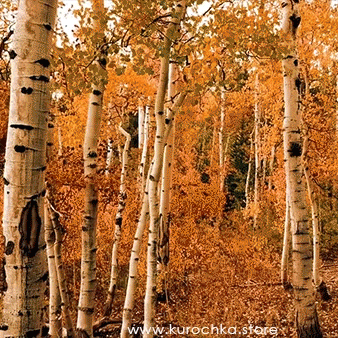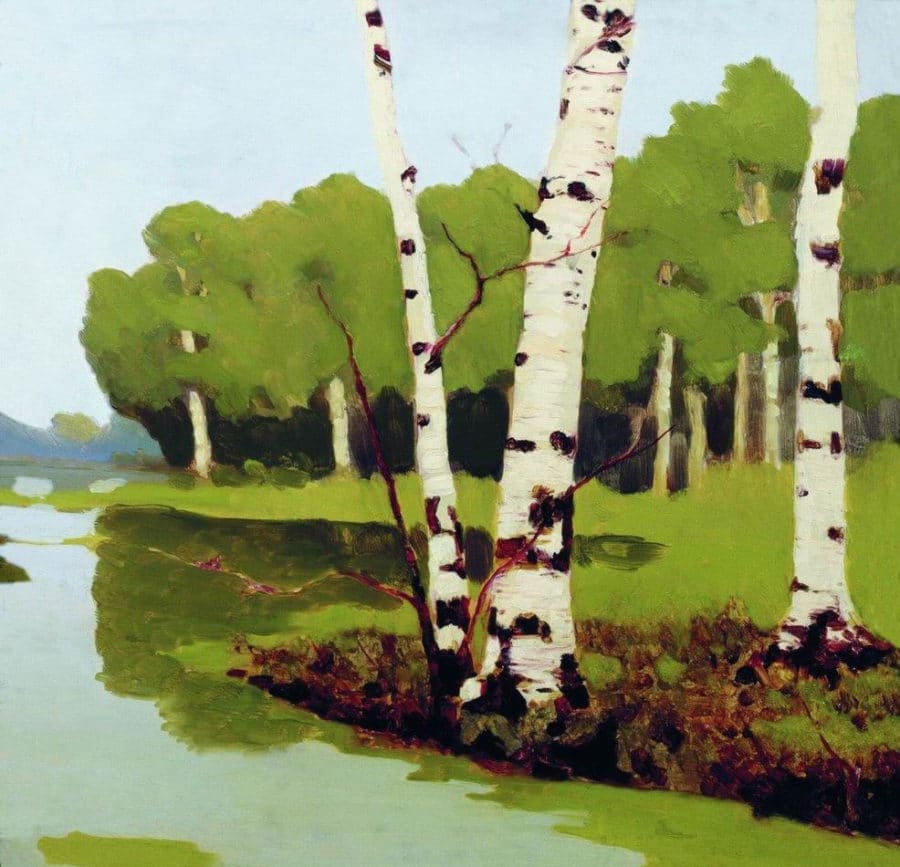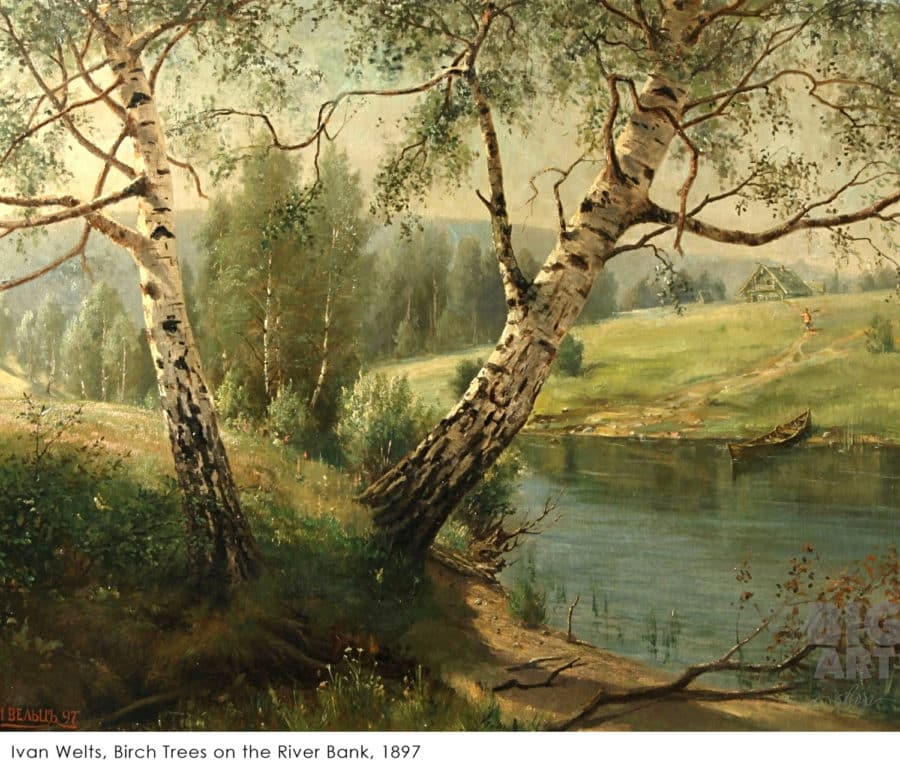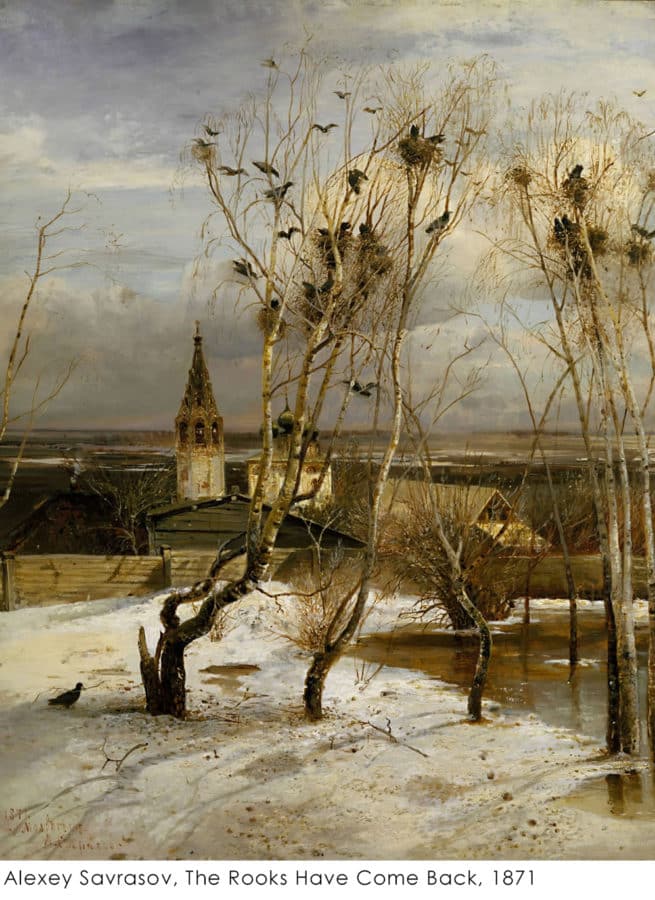 A symbol of Russian nature and Russian beauty, the birch tree (“bereza” or “berezka” in Russian) has a very special place in the country’s culture. It is a poetic symbol of the feminine, a lyrical image of spring, light and virginal purity. The slender birch brings to mind the image of a humble girl, beautiful,and very Russian.
A symbol of Russian nature and Russian beauty, the birch tree (“bereza” or “berezka” in Russian) has a very special place in the country’s culture. It is a poetic symbol of the feminine, a lyrical image of spring, light and virginal purity. The slender birch brings to mind the image of a humble girl, beautiful,and very Russian.
The word “bereza” is very ancient and is connected with the verb “to keep, to take care” (berech), since the Slavs considered the birch as a gift from God, given to them for protection. The birch had to be planted near the house and people tried to surround the village by a protective belt of birches, as they believed that the “birch spirit” can guard against all bad things. A birch was planted near the gate and people could speak with the tree and ask it to give them strength. The birch and things made from it, including birch bark, are considered talismans against evil forces.
Ancient Slavs used its bark to make everything from writing paper to footwear (lapti), and birch bark crafts are one of Russia’s biggest traditions. For centuries, berezka has been famed for its healing qualities. Just strolling in a birch grove is thought to help you stay happy and healthy, and touching a birch tree is believed to restore emotional balance
and reduce stress levels.
So anyone that’s dealing with a lot of stress (which is all of you, right?) is going to have to find themselves some birch trees. Or you can wear Kurochka Clothing’s Birch Tree shirt for instant protection and stress relief.
A couple of interesting facts:
- In the Slavic folk calendar, the birch was assigned a most honorable place; the year began on March 1, the first month of spring, when the birch began to produce sap. It bore the name “Berezen” (bereza). Now the Ukrainian name for March is Beresen.
- In ancient history, the birch could well claim to be the emblem of education. In an era when paper was not yet known, simple Russian people who did not have the opportunity to acquire expensive parchment used birch bark for writing. Archaeological finds suggest a massive use of birchbark manuscripts in Russia.
Tributes to the birch are found in Russian art, songs and poems:
The famous Russian artist Arkhip Kuindzhi, who painted romantic landscapes and sought to render the highest expressiveness in illuminating states of nature, loved to pain birch trees.
There are several variations of Kuindzhi’s Birchtree Grove. He experimented with intensive colors and unusual perspectives to achieve a decorative vibration within the painting.

Another wonderful example of Kuindzhi painting is his Birch Grove of 1879, where he developed a new vision: it is both realistic and conventionalized and looks as a condensed essence of reality. The treatment of the landscape in this painting has nothing reminiscent of the national tradition or popular ideals. The image has a sublime and perfect nature that suggests the dream-like fantasies.

Here are several more birch tree paintings
(but of course there are hundreds of wonderful birch tree art works):




Poem “Bereza” (Birch Tree)
The beautiful poem “Bereza” was written in 1913 by Sergei Yesenin, a very famous Russian poet:
Белая береза Под моим окном Принакрылась снегом, Точно серебром. На пушистых ветках Снежною каймой Распустились кисти Белой бахромой. И стоит береза В сонной тишине, И горят снежинки В золотом огне. А заря, лениво Обходя кругом, обсыпает ветки Новым серебром.
A Russian folk song: “Во поле берёза стояла” (In The Field Stood A Birch)
A girl, the singer, seems to have been married to an old and unloved man; she is going to go into the woods, cut twigs from a birch tree and make musical instruments; she will awaken her old husband and offer him a variety of commands in a somewhat insulting way, so that he could clean himself and dress.
The second part – she is going to go into the woods, cut twigs from a birch tree and make musical instruments; she will play these instruments to awaken her dear, offers him a variety of commands in a very loving way, so that he could clean himself and dress so they could go to the feast.
The Dance
“Berezka” is the name of a very famous Russian ensemble. Every concert put up by the Berezka starts with a folk dance called the Khorovod, in which they perform a sliding step. What’s so special about this step is that they hardly appear to move at all. They really seem to be standing still while the stage beneath them moves. Even the skirts worn by the dancers don’t seem to move.
Other Sources about birch trees:

